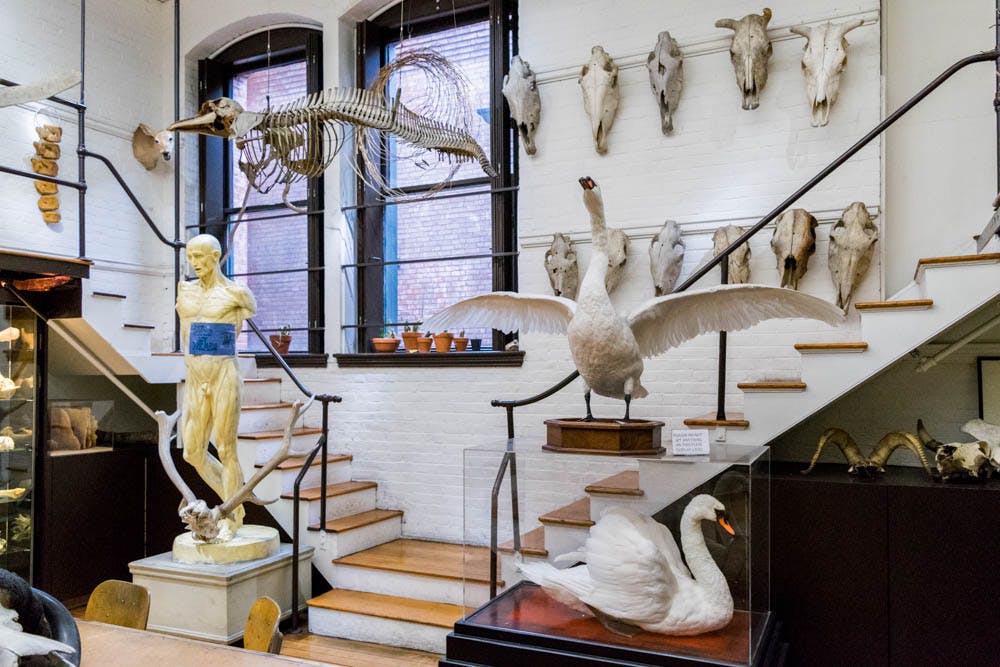Tucked away behind the Rhode Island School of Design Art Museum is another museum of sorts, less frequented by members of the Brown community than its conspicuous neighbor.
Described by Operations and Engagement Coordinator Lucia Monge as “a place where art and science come together to explore the human nature,” the Nature Lab at RISD was founded in the early part of the 20th century by RISD graduate and, later, faculty member Edna Lawrence. From its early beginnings as an extension of Lawrence’s classroom, the Nature Lab’s collection has grown from 300 specimens to the almost 100,000 items that now make up the Lab’s continuously growing collection, said Lab Coordinator Betsy Sara Ruppa.
Lawrence taught nature drawing at RISD for over 40 years and believed strongly that the natural world and all its colors, patterns and shapes could and should positively inform artists’ creativity, Ruppa said. In 1937, RISD’s Waterman building became home to Lawrence’s nature drawing classroom and the host of natural specimens that informed her students’ work. After Lawrence’s retirement in the late 1970s, her nature drawing classroom was formally renamed the Edna Lawrence Nature Lab in her honor, Ruppa said.
The current collection is made up of plants, sponges, skeletons, taxidermy and geometric models, amongst other samplings, as well as technology such as a scanning electron microscope, geographical information systems and high-speed cameras.
“It’s a combination of a natural history museum and a lending library, full of specimens, which are used as a teaching tool,” Ruppa said.
The lab is also home to a few living specimens, including a nine-year-old corn snake named Netop, which means “hello friend” in Wampanoag. Netop is the “most popular creature you’ll ever meet,” Ruppa said. Many RISD students, who come to the lab specifically to visit and play with the gentle snake, are among Netop’s numerous fans and admirers.
There is also a small contingent of axolotls, a type of salamander that, unlike most amphibians, never develops lungs and instead spends its life underwater. While endangered in the wild, axolotls are a popular research specimen. The gilled, legged, neotenous creatures are a common sight in laboratories where their ability to regenerate limbs and — under the duress of hormones or other stressors — morph into land salamanders makes them a fascinating study subject for biology students.
In fact, a biology classroom is exactly how the Nature Lab’s axolotls came to call RISD’s Waterman building home. A Brown student taking a comparative morphology class that worked with axolotl eggs wanted to save the eggs at the end of the lab work rather than have them thrown out, Ruppa said. The student had become acquainted with the Nature Lab after spending her summer working there as a Summer Undergraduate Research Fellow. She decided to bring the eggs to the lab where they developed into a thriving population, she added.
“Here, they are nearly extinct, but they’re used regularly in research labs (all) over the globe,” Ruppa said. “So, they’re all over the place in captivity, but in the wild … (axolotls) are in one little lake (in Mexico).”
Fellowships through SURF, 10-week summer internships funded through the National Science Foundation, are but one of many ways that students are involved with the lab and its work. RISD is the only art school to have received a National Science Foundation grant, Monge said.
RISD students make up a large portion of the Lab’s daily maintenance workforce. Work-study students care for the lab’s living animals and learn how to pin insects, fix skeletons, make displays and acquire new specimens for museums.
Working at the Nature Lab is like being in a “biology or zoology classroom,” said Evan Fredriksen, a RISD student. While Fredriksen spends his time in the classroom majoring in Film/Animation/Video, at the Nature Lab he cares for the lab’s various animals and identifies specimens that the museum gathers based off field guides and other resources. “It’s pretty separate from artwork but uses a lot of the same skills,” Fredrikson said.
“It’s not your typical art school education,” Ruppa said.
The Nature Lab is open for free to the RISD and Brown community, but members of the public must schedule visits and classroom field trips to the lab in order to use its resources. While RISD students primarily take advantage of the lab’s collections, it has increasingly become frequented by classes and individual students from Brown, Monge said. For RISD and Brown students alike, the lab serves as a place for students to “just be” and exist in a “biophilic space,” Monge said.
“Students here can learn from the arts and sciences and from nature itself,” Monge said.





